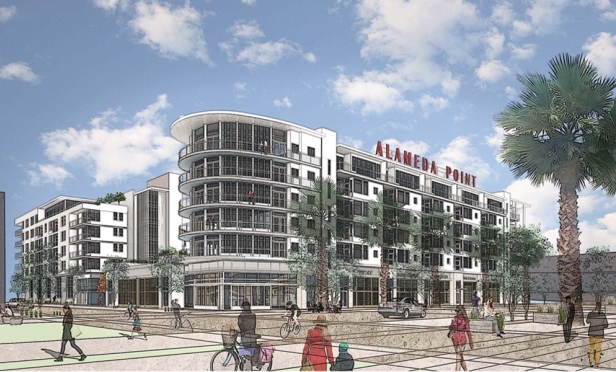
ALAMEDA, CA—Nearly half of the 68-acre Site A parcel at Alameda Point (30 acres) were transferred from the city to Alameda Point Partners, the city's private partner. This transfer paves the way for the mixed-use transit-oriented waterfront development at Site A, the gateway to Alameda Point.
The project represents the first major public/private development at Alameda Point since Naval Air Station Alameda closed, eliminating 18,000 jobs in 1997. The project will create approximately 1,500 on-site permanent jobs and 2,500 direct construction jobs during the life of the project and serve as the catalyst for thousands of future jobs.
Construction of major infrastructure will commence later this month, including new water, sewer, electrical and gas lines, and newly paved streets with bike and transit lanes. Phase one will also include 8 acres of new parks.
The $500 million first phase of the Site A project will consist of 673 housing units, including 130 units of affordable housing for low- and very-low income households, 310 units projected to be affordable to middle-income households, funding for the Seaplane Lagoon Ferry Terminal and 93,000 square feet of retail development. Remaining financing for the affordable housing units is likely in the coming months. Completion of the new infrastructure is expected during the next two to three years, with the first new residences projected to open in 2021.
Alameda Point Partners is a joint venture between Trammell Crow Residential, a division of Dallas-based Crow Holdings, srmERNST Development Partners, Madison Marquette, affordable housing partner Eden Housing and financial partner Cypress Equity Investments. As part of the transfer, the city and Eden Housing received $10 million for a new Seaplane Lagoon ferry terminal, $3 million in funds for affordable housing and a $1 million payment for a planned sports complex.
“The base closed over 20 years ago and several attempts to redevelop it failed. Due to extensive infrastructure requirements, this is a very complicated development. TCR looks forward to delivering an integrated master-planned community on the Bayfront which will not only be a model for other cities struggling with similar redevelopment sites, but also provides the new residents and the city of Alameda with significant public benefits, including a new commuter ferry service to downtown San Francisco,” said Bruce Dorfman, senior managing director of TCR's Northern California division and a member of Alameda Point Partners. Thompson Dorfman Partners was originally selected by the city to develop Site A (with its APP partners srmErnst and Madison Marquette) back in 2014, and merged with Trammell Crow Residential in 2015.
Remaining financing for the affordable housing units is likely in the coming months. Completion of the new infrastructure is expected during the next two to three years, with the first new residences projected to open in 2021. The 25% inclusionary (affordable housing) requirement at Alameda Point is higher than most cities around the Bay Area.
Dorfman said Alameda Point Partners negotiated the sale of several parcels to various builders and developers to coincide with the sale and transfer of the first 30 acres to Alameda Point Partners.
Bock 8–130 units of affordable housing to be developed by Eden Housing. Eden plans to develop a 70-unit family affordable community and a 60-unit senior affordable community.
Block 6–Sold to Trumark Homes to develop 123 townhomes (Block 7 is currently optioned by Trumark Homes), which was marketed and brokered by Moran & Co.
Block 9–Sold to Cypress Equity Investments to develop a 200-unit apartment community with 10,000 square feet of retail/commercial space.
Block 11–Sold to Trammell Crow Residential/Cypress Equity Investments joint venture to develop a 220-unit apartment community and 15,000 square feet of retail/commercial space.
“This is the first truly significant infusion of private capital into the 900-acre naval base,” says Brett Betzler, a partner at Moran & Company. “It will bring it to life and catalyze future development, and also provide much-needed housing to people who work in Alameda, Oakland and San Francisco.”
Upon buildout, the 68-acre master plan development will bring 800 residential units, including 200 affordable units, up to 600,000 square feet of commercial space, 15 acres of parks and public open space, major utility infrastructure benefiting the entire property, and new transportation services and facilities, including the ferry terminal.
“Each of the buildings incorporates design elements that were inspired by the historical use of the base. A number of existing structures will be renovated and incorporated into the community,” said Dorfman.
Site A makes an unprecedented investment in transit infrastructure with a package of multi-modal strategies that complement and build off each other, including the new ferry terminal, bus rapid transit, last mile connection to BART (with shuttle service every 15-minutes in peak periods), bike and car sharing.
“The goal at Site A is to reduce dependency on the automobile and improve alternative modes of transportation by encouraging people to shift a greater share of their trips to public transit, biking and walking,” Dorfman said. “Our investment today is a long-range strategy to alleviate traffic and allow future generations of residents to travel more easily on and off the island.”
All buildings will be constructed with a LEED-Gold Certified rating or equivalent. All Site A structures will be solar ready and meet the latest California building standards codes for solar photovoltaic, and all parking facilities will include electric vehicle charging stations.
“Serving as a home to over 8,000 businesses, Alameda has been highly attractive to tech companies looking to expand their presence in the Bay Area, due in part to relatively affordable office rents, available space options and proximity to the port,” Dorfman tells GlobeSt.com. “The city plans to turn three buildings at the former Alameda Naval Air Station site into a tech campus. The buildings would share proximity to other tech companies already located at the Navy base, such as Google, Saildrone, Natel Energy and Astra Space.”
© 2025 ALM Global, LLC, All Rights Reserved. Request academic re-use from www.copyright.com. All other uses, submit a request to [email protected]. For more information visit Asset & Logo Licensing.








